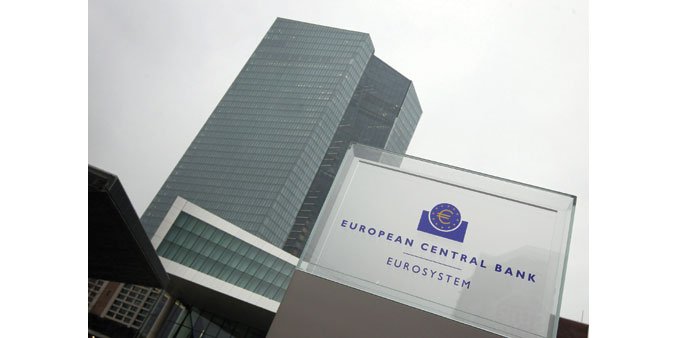The new headquarters of the European Central Bank in Frankfurt. The ECB has taken the baton from the Fed and is leading the way with its €1tn bond-buying programme that will run through September next year.
Reuters
London
After six years of QE, prepare for QT. Faith in the power of “quantitative easing” has prompted central banks, led by the US Federal Reserve, to pump trillions of dollars of stimulus into the global financial system to cushion the impact of the 2007-08 market crisis and recession.
This supply of liquidity continues to flow. The European Central Bank has taken the baton from the Fed and is leading the way with its 1tn euro ($1.1tn) bond-buying programme that will run through September next year. The Bank of Japan is also buying large quantities of bonds.
But a counter flow – call it “quantitative tightening” – is gathering force as China sells foreign exchange reserves to protect its economy and markets from the recent surge of capital out of the country. Other emerging markets are following suit.
Analysts at Citi estimate that global FX reserves have been depleted at an average pace of $59bn a month in the past year or so, and closer to $100bn over the last few months.
A source at another large global bank said emerging market central banks may have sold up to $200bn of FX reserves this month alone, of which $100-$150bn likely came from China.
“The potential for more China outflows is huge,” said George Saravelos, currency analyst at Deutsche Bank in London. “The bottom line is that markets may fear QT has much more to go.”
China is by far the world’s biggest holder of FX reserves, most of which is in dollar-denominated assets like US Treasury bills and bonds.
At the end of June it had $3.69tn compared with around $150bn at the turn of the millennium.
But that has fallen steadily from a peak of almost $4tn a year ago. Some of that is down to exchange rate fluctuations as the dollar has risen, but an increasingly important driver recently is outright selling.
It’s difficult to know with certainty how much and which assets specifically China has sold, because the currency and asset composition of its reserves is not disclosed.
Using International Monetary Fund currency reserves data as a proxy, around two thirds will be in dollars. US Treasury data show that China holds $1.27tn of US bills and bonds, but analysts agree it is substantially more than that.
China and emerging markets led the build-up in global FX reserves following the 1997 Asian crisis to a peak of $12tn last year.
This shielded them from the 2007-09 global crisis, and looks like it is once again being deployed.
The implications of China and others selling off their Treasury holdings are potentially huge.
In isolation, a reserves drop the equivalent to 1% of US GDP (around $178bn) would lead to a rise of 15-35 basis points in the 10-year US Treasury yield, Citi said, citing a range of academic studies.
Yang Zhao, Chief China Economist at Nomura, estimates that the People’s Bank of China sold close to $100bn of FX reserves in July, and again in August.
“Our calculation for capital outflow for July is $90bn. But during July the exchange rate was unchanged, suggesting the PBoC sold a lot of FX ... close to $100bn,” Yang said in a briefing with journalists last week. “After a 3% depreciation the PBoC tried to defend the renminbi and they started to intervene very aggressively. So I would say in August it would (also) be very close to $100bn.”
Plunging commodity prices and fears over growth prospects, particularly in China, have sparked a rush for the emerging market exits.
Figures from CrossBorder Capital, a research and money management firm in London, suggests capital flight from emerging markets in the past year is almost $1tn, of which more than $750bn has come out of China.
This has forced many emerging market central banks to dip into their reserves to manage the fall in their currencies and stop it from turning into an even more savage rout.
But fears of intensifying global “currency wars” have been stoked by China’s devaluation of the yuan earlier this month, renewed slides across global EM exchange rates and subsequent devaluations of the Vietnamese dong and Kazakh tenge.



